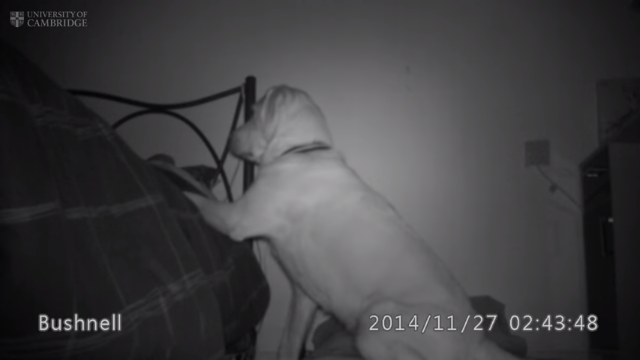A new study that was recently published may explain how dogs are able to detect diabetes. Interestingly, that wasn’t the goal of the research. Dr. Mark Evans, author and consulting physician for the study, told iHeartDogs that the purpose was “to look for a biomarker of blood glucose.” But it was inspired by the anecdotal reports from owners of pets who had detected diabetes, as well as trained service dogs, he explained.

The Study
It is necessary to point out that the study did not include any dogs. As Evans said, they had not set out to discover how dogs detected diabetes. The team wanted to see if there was a way to detect a drop in blood sugar through a person’s breath without having to do a blood test.
To do this, they took breath samples at different blood glucose levels under experimental conditions.
Findings
The research showed that when a person was hypoglycemic, their exhaled isoprene almost doubled, according to Dr. Evans.
They found no correlation between exhaled isoprene and plasma glucose outside of hypoglycemia, according to their paper, “Exhaled Breath Isoprene Rises During Hypoglycemia in Type 1 Diabetes,” which was published in Diabetes Care.
They are still not sure why hypoglycemia may increase isoprene.
How This Relates To Detection Dogs
Although the research did not actually involve dogs, Dr. Evans believes it may answer how they are able to detect when their owners’ blood level drops.
“We didn’t study dogs so we don’t honestly know if what we found is what dogs might detect or not,” Dr. Evans told iHeartDogs. “My bias is that dogs can assimilate information from a range of cues: olfactory, behavioral, and also that dogs are generally very highly attached to their owners.”

But it’s not a quick process. It takes eighteen months of puppy training followed by eight to fourteen months of scent and alert training to get a dog ready for a handler, according to Claire Guest, CEO of Medical Detection Dogs, a nonprofit organization the United Kingdom that trains service animals for medical conditions. This group uses conditioning to train the dogs – pairing a treat with the correct scent to encourage detection.
In the below video, Claire Pesterfield, who had T1 Diabetes explains how her dog Magic has detected 2,500 hypoglycemic “episodes” in two and half years. He even wakes her up in the middle of the night. Dr. Mark Evans is also in the video, explaining the science behind Magic’s ability.
The Medical Detection Dogs website explains their take on dogs’ ability to detect diabetes: “With their amazing sense of smell our dogs are trained to detect minute changes in blood sugar levels and other hormone related odor changes. When these levels fall or rise outside the normal range they will warn their owner, get help and fetch any vital medical supplies.”
So they have been training dogs to smell diabetes even before the new research came out.
“Until Mark published his research we knew the dogs were smelling a chemical associated with a change in blood sugar levels, but didn’t know which chemical was,” Claire Guest, CEO Medical Detection Dogs told iHeartodgs. “Mark’s research helps us to further our understanding of the science behind the dogs’ ability to detect hyperglycemia and hypoglycemia, but will not impact on our training.”
The new research hints that it might be the change in isoprene levels. Dr. Evans said his team will continue to research breath, and he believes there may be other chemicals that change. They also want to measure people in real-life situations instead of in a controlled lab environment.
Medical Detection Dogs is currently working on a new diabetes project as well, which will explore the following, according to Guest:
- Ongoing research looking at sensitivity and reliability of canine alerts
- Longitudinal study looking at health and psychological well-being of individuals who are partnered with a medical alert assistance dog
- Looking at the potential ability of dogs to give ‘pre-alerts’ to rapidly dropping blood sugars
To find out more, you can visit their website.
